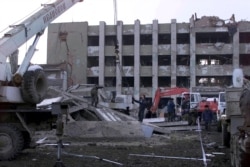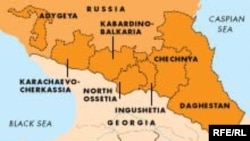The Nogais are a Turkic people descended from the Qipchaks who in the 13th and 14th centuries coalesced with their Mongol conquerors to form the Nogai Horde. They adopted Sunni Islam in the 14th century. Their language is most closely related to Kazakh and Kara-Kalpak. In other words, the Nogais are not ethnically or linguistically even remotely related to the Chechens and Ingush.
Who Are The Nogais?
According to the brief history of the Nogais in Shirin Akiner's "Islamic Peoples Of The Soviet Union," which still remains an invaluable reference source 15 years after the demise of the USSR, the Nogai Horde split in the mid-16th century, with the Great Horde remaining on the lower Volga and the Little Horde settling on the right bank of the Kuban River and the shores of the Sea of Azov, and in southern Ukraine.
The two groups reunited in the mid-17th century after the Great Horde moved southwest, and became nominally subject to the Crimean Tatar khanate. In the 18th century, under pressure from the Tsarist Russian authorities, many Nogais moved either west to present-day Ukraine, south into the Caucasus, or emigrated to Ottoman Turkey.
At the time of the 1979 Soviet census, there were just under 60,000 Nogais in the USSR, while a decade later, that number had increased to some 75,500. Of those, roughly 28,000 lived in Daghestan, primarily in the northern Khasavyurt district. The Nogais constitute the eighth-largest of Daghestan's numerous ethnic groups.
Possibly because they considered themselves victimized, oppressed, or simply neglected and forgotten by the Russian authorities, the Nogais were among the first non-Chechens to join the Chechen resistance.
There are also Nogai communities in neighboring Chechnya, Stavropol Krai, Karachaevo-Cherkessia, and Kabardino-Balkaria. In 1979, over 90 percent of Nogais in the USSR considered Nogai their native language, and 75 percent also claimed fluency in Russian.
An informal Nogai association, Nogai Birlik (Unity), representing the Nogais in Daghestan, in 1991 called for a separate Nogai state, according to a 1995 briefing paper compiled by the British nongovernmental organization International Alert. At that time, the Nogais reportedly opposed sovereignty for Daghestan on the grounds that it would make it more difficult for them to maintain contacts with their coethnics in other regions of the Russian Federation.
Common Cause With The Chechens
Possibly because they considered themselves victimized, oppressed, or simply neglected and forgotten by the Russian authorities, the Nogais, who are overwhelmingly rural dwellers engaged in agriculture, were among the first non-Chechens to join the Chechen resistance.
In a 13 February article, "Nezavisimaya gazeta" traces that involvement as far back as 1996, claiming that between 1996-99 a group of Nogais from Neftekum traveled to Chechnya for training at so-called "Wahhabi camps," presumably meaning the training camp established in Serzhen-Yurt by Saudi-born field commander Khattab.
The Russian daily further claims that the so-called Nogai battalion participated in the 1999 incursion into Daghestan spearheaded by Khattab and radical field commander Shamil Basayev that precipitated the second Chechen war. Whether Nogais from other regions of the North Caucasus have since formed comparable, separate djamaats remains unclear.
Fighting In Stavropol
In December 2005, the head of the Stavropol directorate of the Russian Federal Security Service (FSB), Lieutenant General Oleg Dukanov, claimed that the leader of the so-called Nogai djamaat, which he claimed comprised residents of the Neftekum, Levokum and Stepnov districts of Stavropol Krai, was killed in August 2005 while resisting arrest, regnum.ru reported on 15 December.
If so, the Nogai djamaat apparently retained both its cohesion and its fighting capacity despite the death of its commander. Police claimed to have secured arms -- including six assault rifles, two mortars, and three grenade launchers, together with quantities of ammunition and several walkie-talkies -- in the wake of the Neftekum operation, and claimed that the fighters in question were preparing to launch a major terrorist attack, possibly involving the seizure of a school or orphanage, during the last week of February.
Simultaneously with the Neftekum operation, police detained six alleged militants -- four men and two women -- in Pyatigorsk, also on suspicion of preparing a terrorist act, Interfax reported on 10 February. It is uncertain whether those six were also Nogais, and whether they were coordinating their activities with the Nogai djamaat.
The Chechnya Conflict
 The aftermath of a December 2002 Chechen resistance attack on the main government building in Grozny (epa)
The aftermath of a December 2002 Chechen resistance attack on the main government building in Grozny (epa)
CHRONOLOGY
The fighting in Chechnya has raged, with short breaks, since 1994. It has brought misery, death, and destruction to the North Caucasus republic and to Russia as a whole. View an annotated timeline of the conflict.



















